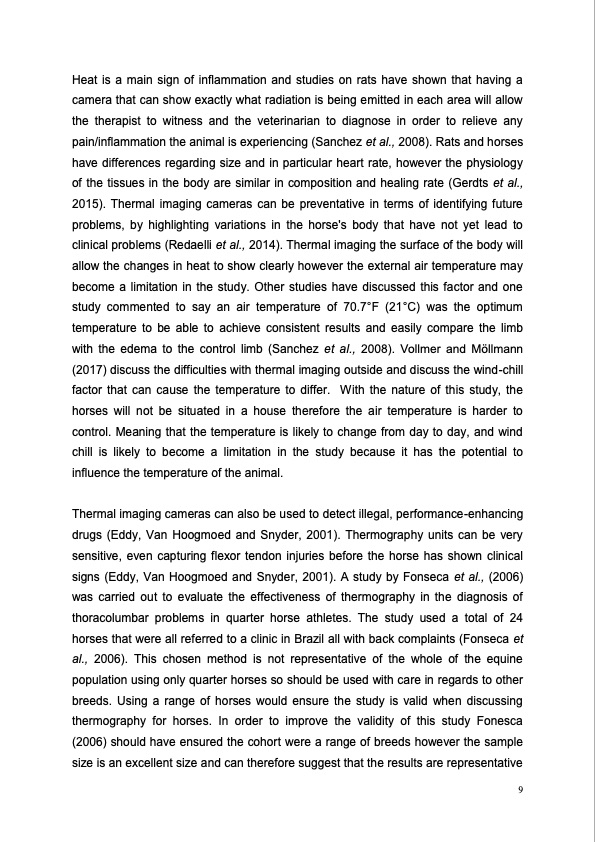
PDF Publication Title:
Text from PDF Page: 016
Heat is a main sign of inflammation and studies on rats have shown that having a camera that can show exactly what radiation is being emitted in each area will allow the therapist to witness and the veterinarian to diagnose in order to relieve any pain/inflammation the animal is experiencing (Sanchez et al., 2008). Rats and horses have differences regarding size and in particular heart rate, however the physiology of the tissues in the body are similar in composition and healing rate (Gerdts et al., 2015). Thermal imaging cameras can be preventative in terms of identifying future problems, by highlighting variations in the horse's body that have not yet lead to clinical problems (Redaelli et al., 2014). Thermal imaging the surface of the body will allow the changes in heat to show clearly however the external air temperature may become a limitation in the study. Other studies have discussed this factor and one study commented to say an air temperature of 70.7°F (21°C) was the optimum temperature to be able to achieve consistent results and easily compare the limb with the edema to the control limb (Sanchez et al., 2008). Vollmer and Möllmann (2017) discuss the difficulties with thermal imaging outside and discuss the wind-chill factor that can cause the temperature to differ. With the nature of this study, the horses will not be situated in a house therefore the air temperature is harder to control. Meaning that the temperature is likely to change from day to day, and wind chill is likely to become a limitation in the study because it has the potential to influence the temperature of the animal. Thermal imaging cameras can also be used to detect illegal, performance-enhancing drugs (Eddy, Van Hoogmoed and Snyder, 2001). Thermography units can be very sensitive, even capturing flexor tendon injuries before the horse has shown clinical signs (Eddy, Van Hoogmoed and Snyder, 2001). A study by Fonseca et al., (2006) was carried out to evaluate the effectiveness of thermography in the diagnosis of thoracolumbar problems in quarter horse athletes. The study used a total of 24 horses that were all referred to a clinic in Brazil all with back complaints (Fonseca et al., 2006). This chosen method is not representative of the whole of the equine population using only quarter horses so should be used with care in regards to other breeds. Using a range of horses would ensure the study is valid when discussing thermography for horses. In order to improve the validity of this study Fonesca (2006) should have ensured the cohort were a range of breeds however the sample size is an excellent size and can therefore suggest that the results are representative 9PDF Image | THE EFFECT OF LIGHT THERAPY ON HEART RATE, HORSES

PDF Search Title:
THE EFFECT OF LIGHT THERAPY ON HEART RATE, HORSESOriginal File Name Searched:
Chloe-Parrett-Dissertation.pdfDIY PDF Search: Google It | Yahoo | Bing
Cruise Ship Reviews | Luxury Resort | Jet | Yacht | and Travel Tech More Info
Cruising Review Topics and Articles More Info
Software based on Filemaker for the travel industry More Info
The Burgenstock Resort: Reviews on CruisingReview website... More Info
Resort Reviews: World Class resorts... More Info
The Riffelalp Resort: Reviews on CruisingReview website... More Info
| CONTACT TEL: 608-238-6001 Email: greg@cruisingreview.com | RSS | AMP |